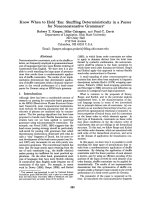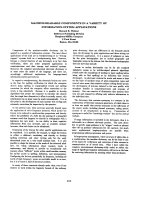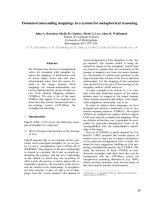DNA oligonucleotide synthesis in a microdevice for multiple analytical applications
Bạn đang xem bản rút gọn của tài liệu. Xem và tải ngay bản đầy đủ của tài liệu tại đây (2.53 MB, 133 trang )
DNA OLIGONUCLEOTIDE SYNTHESIS IN A MICRODEVICE FOR
MULTIPLE ANALYTICAL APPLICATIONS
WANG CHEN
(B. Eng, Zhejiang University)
A THESIS SUBMITTED
FOR THE DEGREE OF DOCTOR OF PHILOSOPHY
DIVISION OF BIOENGINEERING
NATIONAL UNIVERSITY OF SINGAPORE
2010
i
Acknowledgements
First of all, I would like to express my sincere gratitude to my supervisor, Dr. Dieter Trau
for his guidance and support over the course of my Ph.D. study. He has taught me how to
think critically and conduct research independently. His financial support during the last
year of my study helped me pass the most difficult time.
I would like to thank all my lab mates in Nanobioanalystics Lab. Especially, Dr. Mak
Wing Cheung and Ms. Cheung Kwan Yee have taught me a lot of research techniques at
the early stage of my study and gave me a lot of valuable suggestion through the course
of my study. Mr. Bai Jianhao helped me revise my manuscript and suggest me several
good experiments. Ms. Lee Yee Wei helped me purchase everything used in my study.
I would also like to thank Dr. Partha Roy for providing me the photolithography facilities
and A/P Zhang Yong for allowing me use the oxygen plasma machine. I also thank Dr.
Shakil Rehman for his guide on optical detection.
I would also like to thank National University of Singapore for providing me Research
Scholarship for the first four years of my study.
ii
I would also like to thank Ministry of Defence of Singapore. This project is fully
supported by research grant provided by Ministry of Defence. I was also financially
supported by the research grant in the last year of my study. Without this support, this
research cannot be accomplished.
Last but not the least; I would like to thank my family who has always been there for me.
I appreciate the continuous love and encouragement from my parents. Above all, I thank
my wife Wu Liqun for her patience, understanding and unending love. During my most
difficult period, she encouraged me to continue and not give up. She also gave me
unconditional support for all decision I made. Without her accompanying me, this study
could not be completed.
iii
Table of Contents
ACK NOW LED GEM ENT S ················································································································ I
TABLE OF CONTENTS ················································································································· III
SUM MARY ········································································································································ VI
LIST OF TABLES ························································································································· VIII
LIST OF FIGURES ·························································································································· IX
ABBREVIATIONS ·························································································································· X II
CHAPTER 1 INTRODUCTION ······································································································· 1
1.1 Background ············································································································· 2
1.1.1 DNA oligonucleotide ························································································ 2
1.1.2 Microfluidic device ··························································································· 4
1.1.3 Combine oligonucleotide synthesis with microfluidic technologies ················· 5
1.2 Scope and specific aims of study ············································································· 5
CHAPTER 2 LITERATURE REVIEW··························································································· 7
2.1 DNA oligonucleotide synthesis ··············································································· 8
2.1.1 Synthesis chemistry ·························································································· 8
2.1.1.1 Phosphodiester approach ········································································· 10
2.1.1.2 Phosphotriester approach ········································································· 10
2.1.1.3 H-phosphonate approach ········································································· 11
2.1.1.4 Phosphoramidite approach ······································································· 12
2.1.2 Solid phase synthesis ······················································································ 13
2.1.2.1 Solid supports for oligonucleotide synthesis ············································ 15
2.1.2.2 Oligonucleotide synthesizer ····································································· 17
2.1.2.3 In situ oligonucleotide synthesis ······························································ 18
2.2 Microfluidic valve ································································································· 20
2.2.1 Passive and active microvalves ······································································· 20
2.2.2 Pneumatically actuated microvalves ······························································· 22
2.2.2.1 Pneumatic diaphragm microvalve ···························································· 23
2.2.2.2 Pneumatic in-line microvalve ·································································· 26
2.3 Oligonucleotide synthesis in a microfluidic device ················································ 28
2.3.1 Microfluidic device reactor ············································································· 28
2.3.2 Microfluidic oligonucleotide synthesizer ························································ 29
iv
CHAPTER 3 ZERO DEAD-VOLUME MICROVALVE ···························································· 31
3.1 Introduction ··········································································································· 32
3.2 Microvalves design and fabrication ······································································· 35
3.2.1 Zero dead-volume microvalve design ····························································· 35
3.2.2 Microvalve working principles ······································································· 37
3.2.3 Microvalve fabrication ···················································································· 37
3.2.3.1 Master fabrication and PDMS micromolding ·········································· 37
3.2.3.2 PDMS membrane fabrication ··································································· 38
3.2.3.3 Microvalve fabrication ············································································· 40
3.3 Result and discussion····························································································· 43
3.3.1 Microvalve characterization ············································································ 43
3.3.1.1 Microvalve operation ··············································································· 43
3.3.1.2 Leakage pressure ····················································································· 46
3.3.2 Zero dead-volume ··························································································· 47
3.3.3 Minimal cross contamination tested by PCR ·················································· 49
3.4 Conclusion ············································································································· 53
CHAPTER 4 OLIGONUCLEOTIDE SYNTHESIS IN A PORTABLE SYNTHESIZER ···· 54
4.1 Introduction ··········································································································· 55
4.2 Portable oligonucleotide synthesizer ····································································· 57
4.2.1 Software ········································································································· 57
4.2.2 Hardware ········································································································ 59
4.2.3 System integration ·························································································· 60
4.2.4 Microvalve assignment ··················································································· 62
4.3 Materials and methods ··························································································· 62
4.3.1 Chemicals ······································································································· 62
4.3.2 Synthesis reactor ····························································································· 63
4.3.2.1 Reactor for primer synthesis on CPG ······················································· 63
4.3.2.2 Reactor for probe synthesis on glass slide ················································ 64
4.3.3 Surface modification of microscope glass slides ············································· 65
4.3.4 Oligonucleotide synthesis protocol ································································· 66
4.3.5 PAGE and PCR ······························································································· 67
4.3.6 Probe deprotection and hybridization ····························································· 68
4.4 Result and discussion····························································································· 69
4.4.1 PCR primer synthesis ····················································································· 69
v
4.4.2 Probe synthesis ······························································································· 72
4.4.2.1 Probe for oligonucleotide hybridization ··················································· 72
4.4.2.2 Probe for single-base mismatch differentiation ········································ 73
4.5 Conclusion ············································································································· 75
CHAPTER 5 PORTABLE GENERIC DNA HYBRIDIZATION BIOASSAY SYSTEM ······ 76
5.1 Introduction ··········································································································· 77
5.2 System design ········································································································ 78
5.2.1 Texas Red fluorescence detection system ······················································· 78
5.2.2 Integration of fluorescence detection and oligonucleotide synthesis system ··· 79
5.2.2.1 Modified microfluidic chip ······································································ 80
5.2.2.2 Reactor for oligonucleotide synthesis and hybridization ·························· 81
5.2.2.3 Portable DNA bioassay system ································································ 83
5.3 Materials and methods ··························································································· 85
5.3.1 Hybridization probe immobilization on glass slide ········································· 85
5.3.2 Asymmetric PCR ···························································································· 85
5.3.3 DNA hybridization ························································································· 86
5.4 Result and discussion····························································································· 86
5.4.1 Fluorescence detection system ········································································ 86
5.4.1.1 System characterization ··········································································· 86
5.4.1.2 Detection of complementary and single-base mismatch DNA hybridization
····························································································································· 88
5.4.2 Bacterial differentiation ·················································································· 90
5.5 Conclusion ············································································································· 93
CHAPTER 6 CONCLUSION ·········································································································· 94
6.1 Conclusion and original contributions ··································································· 95
6.2 Technical challenges ······························································································ 98
6.3 Future works ·········································································································· 99
BIBLIOGRAPHY ···························································································································· 101
APPENDIX A LIST OF COMPONENTS FOR THE PORTABLE SYSTEM ······················ 114
APPENDIX B ASSIGNMENT OF NI 9476 ················································································· 116
APPENDIX C SPECTRUM OF OPTICAL PARTS FOR FLUORESCENCE DETECTION
····························································································································································· 117
APPENDIX D LIST OF PUBLICATIONS ·················································································· 119
vi
Summary
DNA Oligonucleotide, a short piece of DNA, is one of the most commonly used materials
in biomolecular applications. Nowadays, most oligonucleotides are synthesized in
commercialized oligonucleotide synthesizers. Due to the complexity of the synthesis
process, these synthesizers are bulky in size. Recently, there is an emerging need of on-
site applications of oligonucleotides, such as in civil defense to immediately detect
biological attacks. However, due to the size limitation of the available oligonucleotide
synthesizers, only pre-made oligonucleotides with certain sequence can be brought to the
field. It is practically impossible to get oligonucleotide of any sequence on demand in the
field. In this thesis, a solution is offered by proposing and building a portable
oligonucleotide synthesizer based on microfluidic technology.
Firstly, a microfluidic chip with integrated microvalves is developed. The microvalves
have zero dead-volume characteristic that is attributed to the design of zigzag shaped
main channel and special position of each microvalve. This design removes the
connecting channels between the microvalve and the main channel that are usually found
in traditional designs. Therefore, reagents cannot be trapped within the microfluidic
device and cross contamination can be effectively minimized. The zero dead-volume
characteristic is proven by detection of trace amount of DNA template molecules trapped
in the device. This contamination free characteristic is extremely important for
applications, such as DNA oligonucleotide synthesis, in which cross contamination is
vii
critical issue and can lead to failure of the synthesis.
Secondly, a portable oligonucleotide synthesizer based on the developed zero dead-
volume microchip is built. The portable synthesizer has the ability to synthesize
oligonucleotide as either primer or probe. The sequence and biological functionality of
the synthesized oligonucleotides are proven by polyacrylamide gel electrophoresis, PCR
and DNA hybridization experiment. The portable synthesizer has the ability to synthesize
oligonucleotide of any sequence on demand. To the best of our knowledge, this is the first
reported portable oligonucleotide synthesizer.
To further improve the function of the portable system and realize generic DNA bioassay
within it, a DNA hybridization and fluorescence detection unit is presented and integrated
into the portable synthesizer. The fully integrated system, a portable generic DNA
hybridization bioassay system, is successfully used to distinguish different bacteria
strains based on in situ DNA oligonucleotide synthesis, hybridization and fluorescence
detection. As far as we know, this is also the first portable generic DNA bioassay system
reported. As the system has the potential to detect DNA target of any sequence in the field,
we envisage that the system could help to enable fast responses to emerging bio-threats
for homeland security and in pandemics.
viii
List of Tables
Table 2-1 Reaction scheme of different oligonucleotide synthesis approaches, their
inherent problems and their contributions to the development of oligonucleotide synthesis
chemistry 9
Table 2-2 Categorization of active microvalves 22
Table 4-1 Reagents and reaction time for oligonucleotide synthesis 67
ix
List of Figures
Figure 2-1 Chemical structures of deoxyribonucleotide phosphoramidites. The protecting
groups are labeled in different colors: Red color: acid-labile DMT group to protect 5’-OH.
Blue color: 2-cyanoethyl group to protect phosphite. Green color: isobutyryl or benzoyl
group to protect exocyclic amino group. 13
Figure 2-2 Scheme of solid phase oligonucleotide synthesis. Four reactions are involved
in one synthesis cycle: detritylation, coupling, oxidation and capping. 15
Figure 2-3 Schematic illustrating the working principle of the pneumatically actuated
diaphragm microvalve. (a) The microvalve is closed when positive pressure is applied
through the pneumatic port. (b) The microvalve is opened when negative pressure is
applied, causing the formation of a connecting channel between the thin membrane and
the valve seat. 24
Figure 2-4 Schematic illustrating the working principle of pneumatically actuated inline
microvalve. (a) Microvalve is open at rest. (b) Microvalve is closed when positive
pressure is applied through the pneumatic channel. The thin fluidic layer is pushed down
to close the valve. 27
Figure 3-1 Traditional design of multiple valves integrated microfluidics (a) All inlets are
distributed along the main channel. (b) All inlets merge into the main channel at one point.
33
Figure 3-2 Virtual valve designed by Braschler and co-workers. The process of switching
from reagent B to reagent A. No cross contamination from reagent B is observed after
fully switching to reagent A. 34
Figure 3-3 Design of the microvalves integrated microfluidic device with zero dead-
volume characteristic. The main channel is zigzag shaped. The microvalves are
positioned at each turning point of the main channel. 36
Figure 3-4 Thickness of PDMS membranes vs. spin speed. 2 ml PDMS was applied on
the silicon wafer. 40
Figure 3-5 Schematic diagram depicting the fabrication process of the microvalve (a)
PDMS fluidic layer fabricated by micromolding and fabricated PDMS thin membrane. (b)
Permanent bonding of fluidic layer and thin membrane by treating them with oxygen
plasma. The valve seat is covered to avoid bonding with the thin membrane. (c) Peal off
the fluidic layer-thin membrane complex after baking and then permanent bonding with
pneumatic layer (fabricated also by micromolding) by treating with oxygen plasma. (d)
The device is ready to use after baking for overnight. 42
Figure 3-6 Fabricated microvalves integrated microfluidic chip 43
x
Figure 3-7 Photograph of the microvalve. (a) The microvalve is closed by external
positive pressure through pneumatic channel. (b) The microvalve is opened by external
negative pressure through pneumatic channel. 45
Figure 3-8 Relationship between valve closing pressure and leakage pressure of the
fabricated microvalve 47
Figure 3-9 Photograph of the microvalve showing the zero dead-volume characteristic;
two colored liquids (green and red) are used for illustration. (a) The microvalve that
controls green liquid was opened. (b) The microvalve that controls green liquid was
closed and another microvalve (located at upstream of the main channel) that controls red
liquid was opened. No contamination of the red liquid from the green liquid was observed.
49
Figure 3-10 Trace amount of DNA template molecules detection by PCR and gel
electrophoresis. Lane 1: 100 bp DNA ladder; Lane 2-5: positive control with PCR starting
from 1000, 100, 10 and 0 template molecules; Lane 6-8: PCR with effluent after washing
for 10 s, 20 s and 30 s. (a) Our microvalve design (b) Traditional microvalve design 52
Figure 4-1 Screen shots of the software for controlling oligonucleotide synthesis. The
software was programmed under LabVIEW. (a) The information input interface (b) The
synthesis monitoring interface. 58
Figure 4-2 System design and photograph of portable oligonucleotide synthesizer (a)
Schematic diagram illustrating the complete system, including electrical and electronic
parts, fluidic parts and pneumatic parts. Only four microvalves are shown on the diagram
for simplicity. (b) Photograph of the portable oligonucleotide synthesizer: (1) PC (2)
Argon tank (3) USB-DAQ (4) Solenoid valves and manifold (5) Pressure regulators (6)
Vacuum pump (7) Batteries (8) Microfluidic chip (9) Synthesis reactor (10) Reagents. . 61
Figure 4-3 Assignment of microvalves to oligonucleotide synthesis reagents (1) Washing
(2) Argon (3) Activator (4) A (5) T (6) G (7) C (8) Detritylation (9) Oxidation. 62
Figure 4-4 Reactor for oligonucleotide primer synthesis. (1) PDMS cube (2) Glass fiber
filter (3)(4) FEP tubing (5) CPG. 64
Figure 4-5 Reactor for oligonucleotide probe synthesis. (1) Top acrylic cover with tubing
access holes (2) PDMS microchannel (3) Surface modified microscope glass slide (4)
Bottom acrylic case. 65
Figure 4-6 Scheme of surface modification of microscope glass slide for synthesis of
oligonucleotide probe. 66
Figure 4-7 PAGE image for synthesized oligonucleotide length confirmation. Lane 1:
oligonucleotide ladder. Lane 2: HPLC purified commercial oligonucleotide with the same
sequence. Lane 3: oligonucleotide synthesized by the portable oligonucleotide synthesizer.
70
xi
Figure 4-8 The gel electrophoresis image of PCR product. Lane 1: 50bp DNA ladder.
Lane 2: positive control with both forward and reverse primer purchased. Lane 3: PCR
product amplified by the synthesized oligonucleotide in our portable synthesizer as
reverse primer. 71
Figure 4-9 Fluorescence image of 6-FAM labeled complementary DNA hybridized to
synthesized probe 72
Figure 4-10 Fluorescence image of the synthesized probe hybridizing with Texas Red
labeled oligonucleotide. (a) Complementary sequence. (b) Single-base mismatch. 74
Figure 5-1 (a) Schematic diagram of the Texas Red fluorescence detection system (b)
Photograph of the Texas Red fluorescence detection system. 80
Figure 5-2 Microfluidic chip for oligonucleotide synthesis and DNA hybridization. (a)
Microvalve assignment (1) Washing (2) Argon (3) Activator (4) A (5) T (6) G (7) C (8)
Detritylation (9) Oxidation (10) Hybridization. (b) Fabricated microfluidic chip with 10
microvalves integrated. 81
Figure 5-3 Design of oligonucleotide probe synthesis and hybridization reactor. (1) Top
acrylic cover with tubing access hole (2) PDMS microchannel (3) PT100 temperature
sensor (4) Surface modified glass slide (5) Bottom acrylic case (6) Heating unit with light
access hole. The whole assembly was held together by screw and then fixed inside the
fluorescence detection box. 83
Figure 5-4 Photograph of the portable system: (1) PC with control software (2) Argon
tank (3) NI-DAQ (4) Solenoid valves and manifold (5) Pressure regulators (6) Vacuum
pump (7) Batteries (8) Microfluidic chip (9) Synthesis and hybridization reactor (10)
LED (11) Photodiode (12) Lenses, filters and beam splitter (13) Injection port for
hybridization related reagents. 84
Figure 5-5 Calibration curve for Texas Red fluorescence detection system. The lower
range of the calibration curve (corresponding to amount of Texas Red fluorophore from
0.5 fmol to 12.5 fmol) is enlarged. 88
Figure 5-6 Fluorescence image of hybridization to immobilized probes for test of
fluorescence detection system. (a) Complementary hybridization (b) Single-base
mismatch hybridization. 90
Figure 5-7 3D bar graph showing the fluorescence signal from specific and cross
hybridization between PCR products of two different bacteria strains and synthesized
strain specific probes. 92
xii
Abbreviations
PCR polymerase chain reaction
PDMS poly(dimethylsiloxane)
DMT dimethoxytrityl
CPG controlled-pore glass
PGA photo-generated acid
PFPEs perfluoropolyethers
FEP fluorinated ethylene propylene
MOSFET metal oxide semiconductor field-effect transistor
PFOTCS 1H,1H,2H,2H-perfluorooctyl-trichlorosilane
IPA isopropyl alcohol
ddH
2
O double distilled water
dA 5'-dimethoxytrityl-N-benzoyl-2'-deoxyadenosine,3'-[(2-
cyanoethyl)- (N,N-diisopropyl)]-phosphoramidite
dC 5'-Dimethoxytrityl-N-benzoyl-2'-deoxycytidine,3'-[(2-
cyanoethyl)- (N,N-diisopropyl)]-phosphoramidite
dG 5'-Dimethoxytrityl-N-isobutyryl-2'-deoxyguanosine,3'-[(2-
cyanoethyl)- (N,N-diisopropyl)]-phosphoramidite
dT 5'-Dimethoxytrityl-2'-deoxythymidine,3'-[(2-cyanoethyl)-
(N,N-diisopropyl)]-phosphoramidite
PAGE polyacrylamide gel electrophoresis
SSC saline-sodium citrate
6-FAM 6-carboxyfluorescein
xiii
TxRd Texas Red
LED light emitting diode
NI National Instruments
DAQ data acquisition
APTES 3-Aminopropyltriethoxysilane
DSS disuccinimidyl suberate
DMF dimethylformamide
1
CHAPTER 1
INTRODUCTION
Chapter 1 Introduction
2
1.1 Background
A DNA oligonucleotide is a single stranded, short fragment of DNA. The length of DNA
oligonucleotide usually ranges from a few bases to 50 bases. However, oligonucleotides
with length around 20 bases are more widely used in biomolecular applications and
studies. Applications for DNA oligonucleotides are widely found in biological studies
such as polymerase chain reaction (PCR) which uses DNA oligonucleotide as a primer to
initiate the PCR reaction [1], DNA microarray which uses DNA oligonucleotide as a
probe for DNA hybridization [2], or gene synthesis which uses DNA oligonucleotide as
the basic building blocks to form the target gene [3]. To obtain oligonucleotide with
desired sequence, chemical synthesis of oligonucleotide by polymerizing individual
nucleotide precursors is commonly used.
1.1.1 DNA oligonucleotide
It has been more than 50 years since the first dimer oligonucleotide was chemically
synthesized [4]. Since then, the research on oligonucleotide synthesis chemistry has been
extensively conducted due to numerous applications for DNA oligonucleotides.
Nowadays, the phosphoramidite method has become the ‘golden standard’ approach for
oligonucleotide synthesis [5]. The essence of this method is polymerizing nucleoside
phosphoramidite one by one according to the required sequence. Several different
chemical reactions, which form a synthesis cycle, take place sequentially. One nucleoside
Chapter 1 Introduction
3
phosphoramidite is added onto the growing chain in one cycle. The synthesis of an
oligonucleotide with specific length and sequence requires the repetition of this synthesis
cycle for a number of times. In Chapter 2, various oligonucleotide synthesis chemistries
and recent improvement will be reviewed.
Nowadays, the oligonucleotide synthesis process has been fully automated. Most
oligonucleotides are synthesized in commercialized oligonucleotide synthesizers [6, 7].
However, due to the complexity of the synthesis process, these synthesizers are bulky in
size. Recently, there is an emerging need of “in the field applications” for
oligonucleotides, such as in civil defense to immediately detect biological attacks.
However, due to the size limitation of the available oligonucleotide synthesizers, only
pre-synthesized oligonucleotides with certain sequence can be brought to the field. It is
practically impossible to get any sequence on demand in the field. This is because, for
example, for a 20-mer oligonucleotide, there are totally 4
20
(=1.1 × 10
12
) possible
sequences, the cost for synthesizing and storing all the possible sequences is tremendous
and increases exponentially with the increase in the length of the oligonucleotide.
Therefore, only selected oligonucleotides can be prepared and brought in the field. As a
consequence, no immediate detection and response to artificially manipulated or naturally
mutated agents harmful to human in the field is possible. Thus, it is absolutely necessary
to develop an oligonucleotide synthesizer in a portable format in order to obtain
oligonucleotide with any required sequence in the field.
Chapter 1 Introduction
4
1.1.2 Microfluidic device
Microfluidic device or Lab-on-a-chip has gained a lot of attention and applications in the
past two decades. Its broad applications in biological and chemical studies such as DNA
analysis [8], cell separation [9], cell culture [10], and material synthesis [11] make it a
dynamic research area. The decrease of fluidic devices in dimension to micrometer scale
leads to the dramatic reduction of the volume to microliter or nanoliter. The small volume
of microfluidic devices reduces the consumption of chemicals and production of waste,
which is environment friendly and cost saving. Furthermore, many reactions can be
carried out simultaneously on a single chip, which increases the throughput [12]. The use
of silicon-based polymers in biological studies such as poly(dimethylsiloxane) (PDMS)
also makes the fabrication process of microfluidic device much easier and cheaper
compared to the use of glass or silicon.
Complicated systems based on microfluidic technologies have been reported [8, 12]. In
these microfluidic systems, often microvalves are an important fundamental element,
which implements the fluids control and manipulation in such devices. By integrating a
number of valves in one microfluidic chip, multiple liquid reagents can be controlled in
sequential or parallel manner as needed. Therefore, applications which require adding a
number of different reagents in a certain sequence can be accomplished within
microfluidic system. In chapter 2, various microvalves based on different actuation
strategies will be reviewed, with more details on pneumatically controlled microvalve.
Chapter 1 Introduction
5
1.1.3 Combine oligonucleotide synthesis with microfluidic technologies
As described, DNA oligonucleotide synthesis is such an application in which a number of
reagents are involved. These reagents need to be added into the reactor chamber in a
sequential manner for a series of reactions to take place. As microfluidic device has the
ability to control and manipulate a number of fluids with the aid of microvalve
technologies, combination of microfluidic technologies and DNA oligonucleotide
synthesis chemistry should provide an easy and efficient way to synthesize DNA
oligonucleotide. The microfluidic system can be then packed into a portable format to
form a portable oligonucleotide synthesizer, which can be used for in the field
applications.
1.2 Scope and specific aims of study
As the project is funded by Ministry of Defence of Singapore (MOD), the overall aim of
the research is to develop a portable DNA oligonucleotide synthesizer for MOD for their
in the field applications. The portable synthesizer should have the ability to synthesize
DNA oligonucleotide of any sequence on demand and the synthesized oligonucleotide
can be used as either primer or probe. Furthermore, the function of the portable system
can be extended to conduct DNA hybridization based bioassay. These aims will be
achieved by accomplishing the following four objectives:
Chapter 1 Introduction
6
1. Develop a microvalves integrated microfluidic device which can control the flow of a
number of reagents, the microfluidic device should minimize cross contamination
among reagents within the device;
2. Integrate the microfluidic device with the electronic and pneumatic controlling units,
and pack them into a portable format to form the portable oligonucleotide synthesizer;
3. Synthesize both DNA oligonucleotide primers and probes within the portable
synthesizer;
4. Design a hybridization and fluorescence detection unit and integrate it into the
portable oligonucleotide synthesizer to conduct generic DNA hybridization based
bioassay.
7
CHAPTER 2
LITERATURE REVIEW
Chapter 2 Literature Review
8
2.1 DNA oligonucleotide synthesis
DNA oligonucleotides are one of the most widely used materials in biomolecular
applications and studies. Till now, almost all oligonucleotides used in those applications
are chemically synthesized. However, researchers spent more than 25 years to find the
satisfactory method to synthesize oligonucleotide. As the development of the computer
technology and process automation, oligonucleotide synthesis has been fully automated
and is carried out in commercialized oligonucleotide synthesizers. In this section,
different oligonucleotide synthesis approaches will be reviewed first, followed by recent
advances in solid phase synthesis and oligonucleotide synthesizer design.
2.1.1 Synthesis chemistry
It has been more than 50 years since the first synthesis of a dithymidine dinucleotide was
reported by Michelson and Todd in 1955 [4]. Since then, extensive research has been
conducted on the chemistry of oligonucleotide synthesis due to numerous applications of
DNA oligonucleotides [2, 13-15]. Different approaches have been invented, including
phosphodiester approach, phosphotriester approach, H-phosphonate approach and
phosphoramidite approach. Among these methods, phosphoramidite approach has
become the standard method and has been dominantly used in the past 20 years. However,
it is necessary to understand all these methods and their respective contribution to the
development of the oligonucleotide synthesis chemistry and inherent problems. Table 2-1
Chapter 2 Literature Review
9
shows a brief summary of all these approaches and they will be reviewed in more details
in the following.
Table 2-1 Reaction scheme of different oligonucleotide synthesis approaches, their
inherent problems and their contributions to the development of oligonucleotide synthesis
chemistry
Approach Coupling Reaction Schemes Problems Contributions
Phosphodiester
O
O
O
OR
B
1
P
DMTr
O
O
O
B
2
O
-
+
DMTr
O
O
OH
B
2
O
O
-
O
-
O
P
O
OR
B
2
Branched
p
roduct,
tedious
p
urification
Base and 5’-OH
p
rotection,
elucidation of
genetic code
Phosphotriester
O
O
O
O
B
1
P
DMTr
O
O
O
B
2
RO
Suppor
t
+
DMTr
O
O
O
B
2
RO
O
-
O
P
OH
O
O
B
2
Support
Low coupling
yield
Phosphate
p
rotecting group,
initiate solid phase
synthesis
H-phosphonate
O
O
O
O
B
1
P
DMTr
O
O
O
B
2
H
Suppor
t
+
DMTr
O
O
O
B
2
H
O
-
O
P
OH
O
O
B
2
Support
Side reaction,
incomplete
oxidation
Easy way to get
oligonucleotide
analogues
Phosphoramidite
O
O
O
B
1
P
DMTr
O
O
O
B
2
RO
Suppor
t
+
OH
O
O
B
2
Support
PN
DMTr
O
O
O
B
2
RO
Water
sensitive
Standard approach,
automated process,
synthesis of long
oligonucleotide
Chapter 2 Literature Review
10
2.1.1.1 Phosphodiester approach
In the second half of 1950s, Khorana and his co-workers developed the phosphodiester
approach [16-18]. In the phosphodiester approach, phosphomonoester and the formed
internucleotide phosphodiester are not protected during the coupling reaction, leading to
the problem that oligonucleotides could branch at the internucleotide phosphate.
Therefore, tedious purification is required. Due to these reasons, the phosphodiester
approach was not in use since the 1970s. However, the use of dimethoxytrityl (DMT) as 5’
hydroxyl protecting group [19] and benzoyl and isobutyryl as base protecting group [20]
are very important improvement. These protecting groups are still used in modern
oligonucleotide synthesis (see phosphoramidite approach below). Another contribution
that Khorana has made is the elucidation of genetic code by using this approach to
synthesize short oligomers [21, 22].
2.1.1.2 Phosphotriester approach
In the 1960s, phosphotriester approach was reinvestigated after first reported in 1955 by
Michelson and Todd [4]. Its key difference from the phosphodiester approach is that the
internucleotide phosphate is protected. Therefore, oligonucleotides could not branch at
the internucleotide phosphate. A few protecting groups have been used for protecting the
internucleotide phosphate, including 2-cyanoethyl group [23, 24]. Nowadays this group is
still used in phosphoramidite approach (see below). The problem with this method is that
Chapter 2 Literature Review
11
the coupling efficiency is relatively low, which therefore limits its use in synthesizing
only short oligonucleotide [5]. However, the phosphotriester approach was the first
method used in solid phase synthesis of oligonucleotide [23]. Thereafter, massive
research in this area was initiated and automatic synthesis of oligonucleotide is made
possible due to the success of solid phase synthesis. Nowadays, most of the synthetic
oligonucleotides, if not all, are synthesized by the solid phase approach.
2.1.1.3 H-phosphonate approach
Although first reported by Hall and co-workers in the 1950s [25], this method gained
more attention thirty years later since it was applied to solid phase synthesis of
oligonucleotide [26, 27]. In H-phosphonate approach, only one oxidation reaction is
carried out to convert all the phosphonate diesters to the desired phosphodiesters at the
end of the synthesis (different from phosphoramidite method that oxidation is carried out
in each cycle, see below). The advantage of this method is that only two steps are
involved in one synthesis cycle and oligonucleotide analogues can be easily obtained
during the final oxidation by using different nucleophiles other than water [28, 29].
However, undesired side reaction during coupling and incomplete oxidation in the final
step may lower the final yield of the synthesis. Therefore it is generally accepted that
phosphoramidite approach is superior to H-phosphonate approach in terms of synthesis
efficiency.









